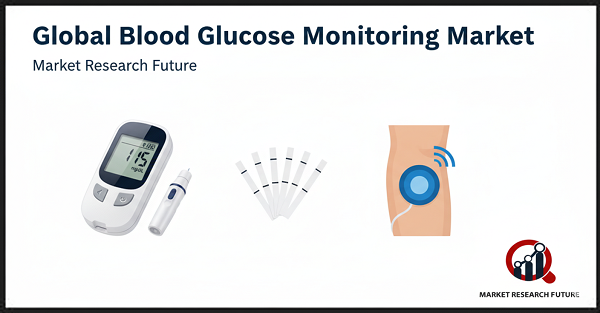Market Research Future (MRFR) has published a cooked research report on the “Blood Glucose Monitoring Market” that contains information from 2025-2035.
The Blood Glucose Monitoring Market is estimated to register a CAGR of 8.35% during the forecast period of 2025 to 2035.
MRFR recognizes the following companies as the key players in the Global Blood Glucose Monitoring Market— Abbott Laboratories (US), Arkay, Inc. (US), Bayer Healthcare AG (Germany), F. Hoffmann-La Roche Ltd (Switzerland), Sanofi (France), GlySure Ltd (UK), Sphere Medical Holding plc. (UK), Dexcom, Inc. (US), LifeScan, Inc. (US), and Novo Nordisk (Denmark).

Blood Glucose Monitoring Market Highlights
The Blood Glucose Monitoring Market is accounted for to register a CAGR of 8.35% during the forecast period and is estimated to reach USD 45.46 Billion by 2035.
The Blood Glucose Monitoring Market is projected to register a CAGR of 8.35% during the forecast period from 2025 to 2035 and is estimated to reach USD 45.46 Billion by 2035. This market encompasses a range of devices and systems designed to measure and monitor blood glucose levels, which play a vital role in diabetes management. The growing global burden of diabetes, driven by sedentary lifestyles, unhealthy eating habits, and increasing obesity rates, is a major factor fueling the demand for blood glucose monitoring solutions.
Blood glucose monitoring enables individuals to track their blood sugar levels in real time, empowering them to make informed decisions about diet, medication, and lifestyle changes. The market is witnessing significant technological advancements, including the introduction of continuous glucose monitoring (CGM) systems, wearable sensors, and smartphone-integrated glucose meters that offer convenience and precision. Furthermore, the rise of remote patient monitoring and telehealth services has enhanced the adoption of smart glucose monitoring devices, particularly among the elderly population and individuals managing chronic diabetes.
Among products, self-monitoring blood glucose (SMBG) devices hold the largest market share due to their affordability and ease of use. However, the continuous glucose monitoring segment is growing rapidly as users increasingly prefer real-time monitoring with minimal invasiveness. Type 2 diabetes remains the dominant application area, reflecting the increasing prevalence of this form of diabetes globally.
Hospitals and clinics continue to be the leading end users, supported by improving healthcare infrastructure and growing healthcare expenditure worldwide. Regionally, North America leads the global market, followed by Europe, while the Asia-Pacific region is expected to experience the fastest growth due to expanding healthcare access and awareness. Overall, advancements in monitoring technologies and growing diabetes prevalence are expected to sustain steady market growth through 2035.
Segment Analysis
The Global Blood Glucose Monitoring Market has been segmented based on Product, Application, and End User.
By Product:
The market is segmented into self-monitoring blood glucose devices and continuous blood glucose monitoring devices. The self-monitoring segment held the largest share in 2021 due to its low cost, convenience, and widespread use in daily diabetes management. This segment is further categorized into blood glucose meters, testing strips, and lancets.
By Application:
The market is segmented into Type 1 Diabetes and Type 2 Diabetes. The Type 2 Diabetes segment dominated the market in 2021, attributed to the rising prevalence of Type 2 Diabetes and the introduction of innovative, less invasive monitoring technologies. Increasing Type 2 Diabetes cases globally will continue to drive segment growth.
By End User:
Based on end user, the market is divided into hospitals & clinics, diagnostic centers, and others. Hospitals and clinics held the largest share in 2021, supported by growing healthcare infrastructure and expenditure. The ability of glucose monitoring devices to provide reliable and rapid data enhances patient care in both inpatient and outpatient settings.
Regional Analysis
The Global Blood Glucose Monitoring Market, based on region, is segmented into North America, Europe, Asia-Pacific, and Rest of the World. North America held the largest market share in 2021, driven by the high prevalence of obesity, advanced healthcare technology, and frequent new product launches by key players. Europe ranked second, supported by an aging population and healthcare system advancements. Germany led the regional market, while the UK was the fastest-growing country in Europe. Asia-Pacific is expected to register the highest growth rate during the forecast period, fuelled by improving healthcare infrastructure, growing diabetic population, and favorable reimbursement policies. China dominated the regional market, whereas India emerged as the fastest-growing market in Asia-Pacific.
Key Findings of the Study
- The Global Blood Glucose Monitoring Market is projected to reach USD 45.46 Billion by 2035, at a CAGR of 8.35% during the forecast period.
- Asia-Pacific is expected to be the fastest-growing region.
- Based on product, self-monitoring blood glucose devices hold the largest market share.
- Based on application, Type 2 Diabetes dominates the market.
- Abbott Laboratories, Dexcom, Inc., F. Hoffmann-La Roche Ltd, Sanofi, and Novo Nordisk are among the key players driving innovation in this sector.
Related Reports:
https://www.marketresearchfuture.com/reports/blood-glucose-monitoring-market-557